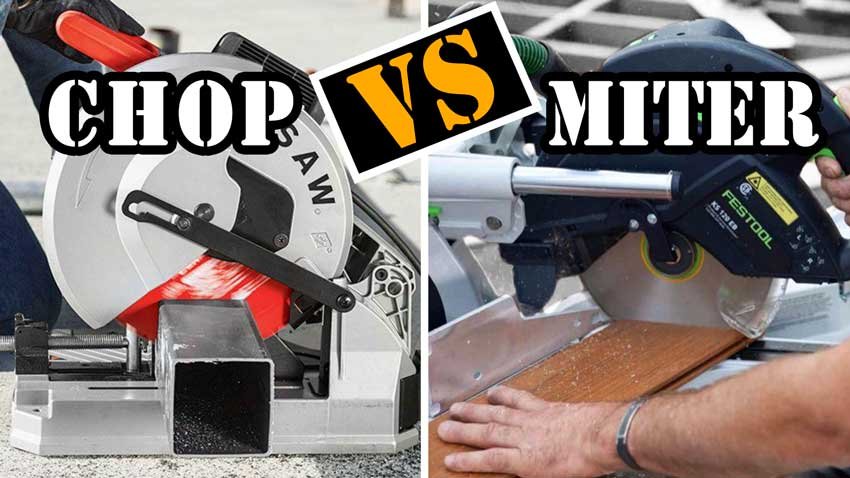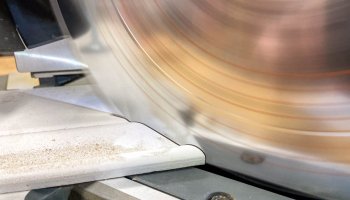
We can’t tell you how many times we’ve heard the term “chop saw” used to describe a miter saw. It’s not a huge deal, but we always try to educate our readers (and those new to the trades) about the differences. It helps to use terminology correctly—particularly when you communicate with other professionals. In looking at a chop saw vs miter saw we can quickly see these are two very distinct tools.
They not only serve different purposes (metal-cutting vs wood), but they also function very differently from one another. This article goes through the various Pros and Cons as well as the differences, strengths, and weaknesses of each of these tools. If you’re more interested in the types of miter saws (compound, sliding, etc) we have an article on that as well.
Key Differences Between the Chop Saw vs Miter Saw
Possibly the best way to differentiate the chop saw vs miter saw is to simply cover the key differences. But first, let’s talk about what makes these two types of saws similar.
Both tools primarily allow for cross-cutting of material. The miter saw and the chop saw both have a back fence to hold material fast while cutting. These tools also both use a circular saw blade with an exposed bottom cutting edge that spins away from the user.
With both of these tools, users need to keep their hands a minimum distance away from the cutting blade for safety. Currently, both tools may offer clamping systems to help stabilize material for cuts.
Now, let’s look at some key differences.
Chop Saw Features (as Opposed to Miter Saws)
- Makes straight cuts with a blade that does not bevel or miter
- Designed to cut metal (steel, aluminum, etc)
- Typically use abrasive cutting wheels
- Blade sizes up to 15-inches (12–15″ typical)
- Often includes clamps to hold material
- Can be high speed (abrasive) or “cold-cutting”
Miter Saw Features (as Opposed to Chop Saws)
- Makes straight or beveled cuts with a blade that also miters
- Primarily designed to cross-cut wood (trim, framing lumber, etc)
- Use carbide-tipped blades
- Blade sizes up to 12-inches (7-1/4 to 12″ typical)
- May include table clamps for holding material
If you plan to cut a lot of metal at angles, you may have a tougher decision. When looking at chop saws vs miter saws for metal, we tend to gravitate towards anything that can help us use a carbide-tipped “cold-cutting” blade. That brings us to the topic of hybrid metal- and wood-cutting miter saws.
Some companies, like Evolution Power Tools, offer saws designed to cut both metal and wood. These tools use blades (or have multiple blade options) that handle both materials fairly well. They often operate at much lower RPMs instead of the typical 3500+ RPM of chop saws.
A typical hybrid saw more closely resembles a compound sliding miter saw than a chop saw. The “hybrid” functionality has more to do with the slower blade speed and the blade.

A hybrid saw often functions similarly to a cold cut saw in that it uses a slower blade speed. That slower blade speed means it can use a carbide-tipped metal-cutting blade and doesn’t require an abrasive wheel like high-speed saws.
Chop Saw vs Miter vs Hybrid Saws Compared
We also put the above (and more) into a table for easy observation:
| Chop Saw | Miter Saw | Hybrid Saw | |
|---|---|---|---|
| Possible cut types | Cross cuts (90°) | Straight, bevel, miter, compound | Straight, bevel, miter, compound |
| Square material capacity | up to 4-3/4 in. | around 4 in. | around 4 in. |
| Round material capacity | up to 5-1/8 in. | N/A | up to 4 in. |
| Rectangular capacity | 4 x 7-5/8 in. 2-3/4 in. x 9-1/8 in. |
up to 2 x 12 in. | up to 2 x 12 in. |
| Blade sizes | 12–15 in. | 7-1/4 to 12 in. | 10–12 in. |
| Types of blades | abrasive, diamond | carbide | carbide |
| Blade speed | fast | fast | slow |
| Material it can cut | steel | wood | steel, aluminum, wood |
| Weight | heavy | lightweight to heavy | lightweight to heavy |
Chop Saw vs Miter Saw Blades – Abrasive vs Carbide-tipped Steel
Most chop saws use abrasive metal-cutting blades. The reasons are many. Primarily, however, these blades are inexpensive and they get the job done. Abrasive blades offer consistent, though imprecise, cutting of most soft steels. They really tend to have difficulty making more precise miter cuts since they inherently deflect and flex during use.
Don’t use a standard abrasive cutting disc on aluminum, either. The soft aluminum will quickly gum up the edge of the wheel and render it useless in a very short period of time.

Chop saws designed for abrasive wheels aren’t compatible with slower-speed (RPM) saws that use carbide-tipped blades for cutting various metals. You can find some steel blades designed for higher-speed saws. One example is the Milwaukee Steelhead Diamond cut-off blade. It uses exposed synthetic diamond grits along the cutting edge. We also don’t recommend using a blade like this one on aluminum. For that, we’d opt for a slower saw with a carbide blade.

On those saws which use slower RPMs to cut metal, you can find a variety of carbide-tipped cutting blades. These resemble a traditional wood blade, but they come optimized for cutting steel more safely. Some also prioritize softer metals like aluminum.

Chop Saw vs Sliding Miter Saws
We’ve addressed beveling in our discussion of the chop saw vs miter saw decision. One thing yet to be addressed has to do with capacity or depth of cut. Most metal chop saws deal with cross-cutting short pieces of metal 4-inches or smaller.
If for some reason, you need to cut larger pieces of metal, you might think a sliding miter saw could offer a solution. While technically true, the better solution might be a handheld metal-cutting saw like the Milwaukee cordless metal cutting saw.
With larger cross-cut lengths, you want to be very careful when using a tool like a miter saw to cut metal. A dedicated metal saw creates a much more safe situation when making longer cuts and affords you a better opportunity to secure the piece while cutting.
Final Thoughts and Other Considerations
We can’t possibly hit every conceivable topic related to the chop saw vs miter saw question. Once you understand the various issues: cutting speed, capacity, and the type of material and cut, you should be better equipped to make an informed choice.
We can’t emphasize enough the need to pay close attention to blade speed. When it comes to picking up a carbide blade for cutting metal, RPM/speed matters. Don’t put a low speed metal blade on a high-speed miter saw in an attempt to convert your tool. Rather, look for a metal-cutting blade that matches the speed of your saw. That provides a safe, effective method of cutting metal on a miter saw or similar tool.
The same goes for chop saws. Some saws come designed for use with slower-speed steel blades while standard chop saws have the higher RPMs needed for abrasive cutting wheels. Match the blade to the saw!
For even more recommendations, check out our best miter saw article as well as our article on the best cordless circular saws. Both contain tools designed to cut both metal and wood.






